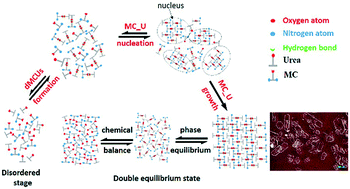Molecular recognition and self-assembly mechanism of cocrystallization processes†
Abstract
In this work, the molecular recognition and self-assembly mechanism of cocrystallization processes was investigated by using m-cresol as a model compound. First of all, single cocrystals of m-cresol_urea (MC_U) were obtained and their structure was determined. The molecular interactions inside the cocrystals were analyzed and characterized by differential scanning calorimetry (DSC), Fourier transform infrared spectrometry (FTIR), 1H-nuclear magnetic resonance (1H NMR) and Raman spectroscopy. It was found that the MC_U cocrystal molecules exhibit a crossed-layer structure with two channels. Urea layers and MC layers are intersected by strong intermolecular hydrogen bonds, weak intermolecular hydrogen bonds and other weak secondary bonds. To unveil the molecular recognition and self-assembly mechanism during the formation process of the MC_U cocrystals, several process analytical technology (PAT) tools were used to monitor the cocrystallization process in situ. It was found that m-cresol-urea dimers (dMCUs) were firstly formed before the appearance of MC_U cocrystals. The critical temperature for the existence of dMCUs was identified to be between 74.11 °C and 74.46 °C. It was proposed that the formation process of MC_U cocrystals can be divided into three steps: (1) dMCU formation, (2) MC_U cocrystal nucleation and (3) MC_U cocrystal growth.



 Please wait while we load your content...
Please wait while we load your content...